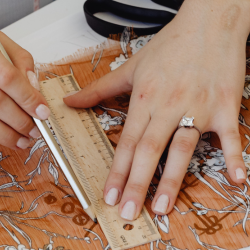Photography is the art of seeing, not just what’s in front of you, but how you frame it with your instrument i.e. camera. Among the golden rules & various strategies in photography that define professional photography, one thing stands tall: the Rule of Thirds.
It’s one of those ideas that looks simple at first, yet once you start applying it in your style, you realize, how deeply it changes the way you click and plan your shots and location placement. Whether you’re using a DSLR, mirrorless, or smartphone, understanding the Rule of Thirds in photography can transform your images from ordinary photos into visually compelling stories.
- What Does the Rule of Thirds Mean in Photography?
- How the Rule of Thirds Improves Composition
- Rule of Thirds Photography Tips
- Common Mistakes to Avoid with the Rule of Thirds
- Advanced Applications of the Rule of Thirds in Photography
- FAQs
- What is the rule of thirds in photography?
- How does the rule of thirds improve your photos?
- Can the rule of thirds be applied to all types of photography?
- What is the best way to apply the rule of thirds in landscape photography?
- How do I know if I’m following the rule of thirds correctly?
- Can I break the rule of thirds in photography?
- How can I use the rule of thirds in portrait photography?
- Why should I avoid centering my subject in a photograph?
What Does the Rule of Thirds Mean in Photography?
The Rule of Thirds divides your image into a grid of nine equal parts, two horizontal and two vertical lines. Imagine a tic-tac-toe board laid over your photo, or else some mobile phone camera also has that grid kind of line in neural. The key idea is to place the most important elements of your scene in your subject, which is your friend or can be anyone, a colorful sky, or a point of interest along these lines or at their intersections. These intersection points are often called “power points” because they draw the viewer’s eye naturally.
This technique prevents your photo from feeling static or from being viewed from a symmetrical angle. Instead, it creates in balance, energy, and movement qualities that keep the viewer’s attention longer.
How the Rule of Thirds Improves Composition
The Rule of Thirds is effective because it mirrors how the human eye naturally views the world. We’re subconsciously drawn to off-center points rather than dead-center objects in general and from our minds.
By aligning your subject according to the grid, you:
- Create balance between your subject and background.
- Add movement, making the photo feel alive and dynamic.
- Encourage visual storytelling — the viewer’s eyes follow your frame from one element to another.
It’s less about following a formula and more about teaching your eyes to see differently.
Rule of Thirds Photography Tips
Here are some of the tips consolidated by the best photographers:
Tip 1 – Use the Grid Feature on Your Camera
Almost every digital camera and smartphone today offers a grid option in the display settings. Turn it on before shooting.
This visual guide helps you practice aligning your subjects with precision. Over time, you’ll start “seeing” the grid even without it.
Check out: Digital Photography
Tip 2 – Place Key Subjects at Intersections
The intersections of the grid are where the magic happens. Placing your main subject — like a face, building, or tree — on one of these four points instantly enhances the impact.
This positioning gives the viewer a comfortable balance: the photo feels intentional yet natural.
Tip 3 – Avoid Centering the Subject
Centering might feel instinctive, but it often leads to flat compositions. By offsetting the subject, you invite curiosity.
For example:
- A bird flying into the frame looks more natural when you leave space in front of it.
- A portrait looks more engaging when the subject’s gaze leads into open space rather than out of frame.
Tip 4 – Balance the Composition with Negative Space
Negative space is the empty area around your subject — sky, water, walls, etc.
Using the Rule of Thirds helps you use this emptiness wisely.
For instance, if your subject occupies one-third of the frame, leave two-thirds open to convey simplicity, scale, or solitude. This contrast often tells more story than a busy frame.
Tip 5 – Apply the Rule to Both Horizontal and Vertical Shots
The Rule of Thirds works in both orientations. In vertical (portrait) photography, align your subject’s eyes or focus point near the upper intersection. In horizontal (landscape) shots, align horizons or architectural elements to balance depth and width.
Also Know About: Basics Of Photography
Common Mistakes to Avoid with the Rule of Thirds
While starting out with photography, most of the time, newcomers make these mistakes.
Mistake 1 – Ignoring the Subject’s Direction
When your subject is facing or moving in one direction, leave more space in front of them than behind.
This “lead room” makes the photo feel balanced and natural — otherwise, it might seem like your subject is walking out of the frame.
Mistake 2 – Overusing the Rule
The Rule of Thirds is a guide, not a law.
If you use it rigidly for every photo, your compositions may start to look predictable. Once you’ve mastered it, learn when to break it — centered portraits, symmetrical architecture, or reflections often benefit from balance rather than thirds.
Mistake 3 – Not Considering the Background
Even with perfect subject placement, a cluttered or distracting background can ruin your composition.
Keep an eye on the background elements — lines, lights, or people — and ensure they don’t steal attention from your subject.
Read in detail about: Photography Mistakes to Avoid
Advanced Applications of the Rule of Thirds in Photography
After learning the basics of the rule of thirds, here are some advanced applications for it.
Using the Rule of Thirds for Leading Lines
Leading lines — like roads, fences, rivers, or pathways — naturally draw attention.
When you align these lines along the thirds, you guide the viewer’s eyes straight toward the subject or deeper into the frame.
This creates depth and direction, giving the photo a cinematic feel.
Rule of Thirds in Portrait Photography
In portraits, try positioning the subject’s eyes along the upper third of the frame. This instantly makes the composition more expressive and grounded. If your subject is turned sideways, align their face on one vertical third line, leaving open space in the direction of their gaze.
Combining the Rule of Thirds with Other Composition Techniques
Once you master the Rule of Thirds, you can blend it with:
- Symmetry – for balanced yet artistic shots.
- Framing – using natural frames (windows, arches, trees) to highlight the subject.
- Depth of field – keeping your subject sharp and the background soft for emotional impact.
These techniques elevate your work from simply “well-composed” to emotionally powerful.
Also Know About: Advanced Photography Techniques
Mastering the rules of thirds can instantly improve your compositions and bring more balance to your photos. If you want to sharpen your skills further, enrolling in a Photography Course Online can help you learn essential techniques and elevate your photography to the next level.
FAQs
What is the rule of thirds in photography?
It’s a composition technique that divides your frame into nine equal parts to place your main subject along lines or intersections, creating balance and visual interest.
How does the rule of thirds improve your photos?
It helps direct the viewer’s attention naturally and adds a sense of proportion, preventing flat or static images which are bore.
Can the rule of thirds be applied to all types of photography?
Yes. It’s used in portrait, landscape, wildlife, street, and product photography — even cinematography follows this principle.
What is the best way to apply the rules of thirds in landscape photography?
Place the horizon either on the top or bottom third to balance the sky, land and everything that you want, depending on which element you want to emphasize.
How do I know if I’m following the rules of thirds correctly?
Turn on your camera’s gridlines and check that your friend, who is acting as subject, aligns with one of the intersections or main lines.
Can I break the rule of thirds in photography?
Yes — once you understand the rule, breaking it intentionally can lead to dramatic or minimalist results. The goal is to make the viewer feel something, not just follow a formula.
How can I use the rule of thirds in portrait photography?
Align your subject’s eyes along the top horizontal line, and position them slightly to one side for natural flow.
Why should I avoid centering my subject in a photograph?
Centering can make your shot feel flat or predictable, while the Rule of Thirds adds rhythm, direction, and narrative energy.






















